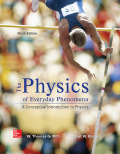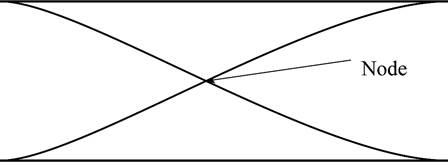
Concept explainers
A pipe that is open at both ends will form standing waves, if properly excited, with antinodes near both ends of the pipe. Suppose we have an open pipe 60 cm in length.
a. Sketch the standing-wave pattern for the fundamental standing wave for this pipe. (There will be a node in the middle, and antinodes at either end.)
b. What is the wavelength of the sound waves that interfere to form the fundamental wave?
c. If the speed of sound in air is 340 m/s, what is the frequency of this sound wave?
d. If the air temperature increases so that the speed of sound is now 358 m/s. by how much does the frequency change?
e. Sketch the standing-wave pattern and find the wavelength and frequency for the next harmonic in this pipe.
(a)
Sketch the sound-wave pattern for this pipe.
Answer to Problem 3SP
The fundamental wave pattern in the pipe is drawn.
Explanation of Solution

Conclusion:
Therefore, the fundamental sound-wave pattern is drawn.
(b)
The wavelength of the sound wave.
Answer to Problem 3SP
The wavelength is
Explanation of Solution
Given Info: The length of the pipe is
Write the formula to calculate the fundamental wavelength inside the pipe.
Here,
L is the length of the pipe
Substitute
Conclusion:
Therefore, the wavelength is
(c)
The frequency of the sound wave.
Answer to Problem 3SP
The frequency of the sound wave is
Explanation of Solution
Given Info: The wavelength of the sound wave is
Write the expression to calculate the speed of the sound wave.
Here,
f is the frequency of the sound wave
Substitute
Conclusion:
Therefore, the frequency of the sound wave is
(d)
The change in frequency of the sound wave.
Answer to Problem 3SP
The change in frequency of the sound wave is
Explanation of Solution
Given Info: The wavelength of the sound wave is The longest possible wavelength is
Write the expression to calculate the speed of the sound wave.
Here,
Substitute
Write the formula to calculate the frequency change for the sound wave.
Here,
Substitute
Conclusion:
Therefore, the change in frequency of the sound wave is
(e)
Sketch the standing-wave pattern for the next harmonic and find wavelength and frequency.
Answer to Problem 3SP
The frequency of the second harmonic wave is
Explanation of Solution
For the second harmonic, the frequency is twice as that of the fundamental standing-wave and wavelength is half of that value of the fundamental standing wave. Therefore the frequency of the second harmonic wave is
The sketch of the second harmonic wave is shown below.

Conclusion:
Therefore, the frequency of the second harmonic wave is
Want to see more full solutions like this?
Chapter 15 Solutions
Physics of Everyday Phenomena
- 20. Two small conducting spheres are placed on top of insulating pads. The 3.7 × 10-10 C sphere is fixed whie the 3.0 × 107 C sphere, initially at rest, is free to move. The mass of each sphere is 0.09 kg. If the spheres are initially 0.10 m apart, how fast will the sphere be moving when they are 1.5 m apart?arrow_forwardpls help on allarrow_forwardpls help on thesearrow_forward
- pls help on all asked questions kindlyarrow_forwardpls help on all asked questions kindlyarrow_forward19. Mount Everest, Earth's highest mountain above sea level, has a peak of 8849 m above sea level. Assume that sea level defines the height of Earth's surface. (re = 6.38 × 106 m, ME = 5.98 × 1024 kg, G = 6.67 × 10 -11 Nm²/kg²) a. Calculate the strength of Earth's gravitational field at a point at the peak of Mount Everest. b. What is the ratio of the strength of Earth's gravitational field at a point 644416m below the surface of the Earth to a point at the top of Mount Everest? C. A tourist watching the sunrise on top of Mount Everest observes a satellite orbiting Earth at an altitude 3580 km above his position. Determine the speed of the satellite.arrow_forward
- pls help on allarrow_forwardpls help on allarrow_forward6. As the distance between two charges decreases, the magnitude of the electric potential energy of the two-charge system: a) Always increases b) Always decreases c) Increases if the charges have the same sign, decreases if they have the opposite signs d) Increases if the charges have the opposite sign, decreases if they have the same sign 7. To analyze the motion of an elastic collision between two charged particles we use conservation of & a) Energy, Velocity b) Momentum, Force c) Mass, Momentum d) Energy, Momentum e) Kinetic Energy, Potential Energyarrow_forward
 Glencoe Physics: Principles and Problems, Student...PhysicsISBN:9780078807213Author:Paul W. ZitzewitzPublisher:Glencoe/McGraw-Hill
Glencoe Physics: Principles and Problems, Student...PhysicsISBN:9780078807213Author:Paul W. ZitzewitzPublisher:Glencoe/McGraw-Hill University Physics Volume 1PhysicsISBN:9781938168277Author:William Moebs, Samuel J. Ling, Jeff SannyPublisher:OpenStax - Rice University
University Physics Volume 1PhysicsISBN:9781938168277Author:William Moebs, Samuel J. Ling, Jeff SannyPublisher:OpenStax - Rice University Principles of Physics: A Calculus-Based TextPhysicsISBN:9781133104261Author:Raymond A. Serway, John W. JewettPublisher:Cengage Learning
Principles of Physics: A Calculus-Based TextPhysicsISBN:9781133104261Author:Raymond A. Serway, John W. JewettPublisher:Cengage Learning Physics for Scientists and Engineers: Foundations...PhysicsISBN:9781133939146Author:Katz, Debora M.Publisher:Cengage Learning
Physics for Scientists and Engineers: Foundations...PhysicsISBN:9781133939146Author:Katz, Debora M.Publisher:Cengage Learning College PhysicsPhysicsISBN:9781938168000Author:Paul Peter Urone, Roger HinrichsPublisher:OpenStax College
College PhysicsPhysicsISBN:9781938168000Author:Paul Peter Urone, Roger HinrichsPublisher:OpenStax College Physics for Scientists and Engineers, Technology ...PhysicsISBN:9781305116399Author:Raymond A. Serway, John W. JewettPublisher:Cengage Learning
Physics for Scientists and Engineers, Technology ...PhysicsISBN:9781305116399Author:Raymond A. Serway, John W. JewettPublisher:Cengage Learning





